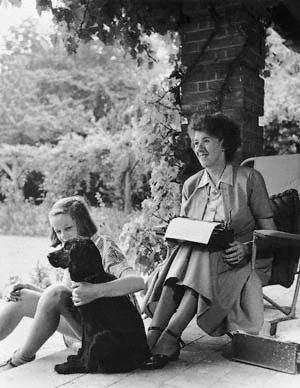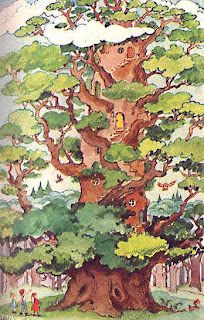The Faraway Tree is a series of four novels for children written by Enid Blyton
English children's writer whose books have been among the world's best-sellers since the 1930s, selling more than 600 million copies.: The Enchanted Wood (1939), The Magic Faraway Tree (1943), The Folk of the Faraway Tree (1946) and Up the Faraway Tree (1951).
The stories are set in an enchanted wood in which a gigantic magical tree grows – the titular Faraway Tree. The tree is so tall that its topmost branches reach into the clouds, and it is wide enough to accommodate small houses carved into its trunk. Jo, Bessie and Fanny, three siblings, discover the tree after their family moves into a house close to the wood. The Faraway Tree is inhabited by fairies, and its topmost branches lead to ever-changing magical lands, where the children’s adventures take place. The children are free to come and go as they please, but if they fail to leave before the land they are in moves on they are trapped until that same land returns to the Faraway Tree.
Notable lands include the Land of Birthdays, the Land of Goodies, the Land of Take-What-You-Want, the Land of Do-As-You-Please, and the Land of Dame Slap.
Publication history
The first book of the main trilogy, The Enchanted Wood, was published in 1939, although the Faraway Tree and Moon-Face had already made a brief appearance in 1936 in The Yellow Fairy Book. A picture-strip book, Up the Faraway Tree, was published in 1951. The stories have been illustrated by various artists including Dorothy Wheeler, Rene Cloke, Janet and Anne Grahame Johnstone, and Georgina Hargreaves.[1]
Characters
The main characters are Jo, Bessie and Fanny, three siblings. Fanny is the youngest, Bessie is next in age and Jo is their big brother. They live near the enchanted wood and become friendly with the residents of the Faraway Tree. Other characters include:
- The Angry Pixie, who lives in a house with a tiny window and has a habit of throwing cold water or any liquid at hand over people who dare to peep inside.
- An owl lives in the house next to the Angry Pixie’s. He is a friend of Silky’s.
- Silky the fairy, named after her long, silky, golden hair. She is one of the children’s regular companions when they go up the Tree to other worlds.
- Mr. Watzisname cannot remember his name. He sleeps and snores all the time. During a particular story at the Land of Secrets, Mr. Watzisname discovers that his name is Kollamoolitumarellipawkyrollo. This is forgotten by the end of the story (even by the man himself) and he goes back to being Mr. Watzisname.
- Dame Washalot, who spends her time washing her clothes and throwing the dirty wash-water down the tree. If she has no clothes to wash she washes other people’s laundry, and even the leaves of the Faraway Tree.
- Moon-Face, named for his round face that looks like the moon. His house is similarly round, and is filled with curved furniture. He is the owner of the slippery-slip, a slide in the middle of his house which goes to the bottom of the Faraway Tree; given its obvious use as a means of gaining access to the tree, it has played an important role in some of the adventures in which others have sought control of the tree or its rooms.
- The Saucepan Man, who lives with Mr. Watzisname. Sometimes he cannot understand what his friends are saying because he is partially deaf, which is further aggravated by the noise from the pans and kettles he always carries. The Saucepan Man also appears in another lesser-known Blyton book, The Book of Brownies (aka Brownie Tales), helping the travellers on their journey.
- The Saucepan Man’s mother, who lives with Dame Washalot after The Folk of the Faraway Tree. She runs a cake shop.
- Dame Snap, who runs a school for bad pixies which, in some of the adventures, the friends accidentally land in.
Revisions
In modern reprints, the names of some of the characters have been changed. Jo has become Joe, the more common spelling for males, and Bessie is now called Beth, the former name having fallen out of fashion as a nickname for Elizabeth. Fanny, whose name has come to carry unfortunate connotations to a modern reader, has been renamed Frannie. Dame Slap has become Dame Snap, and no longer practises corporal punishment, instead reprimanding her students by shouting at them.[2]
Adaptations
Stories from the novels were adapted into ten-minute episodes for the 1997 BBC television series Enid Blyton’s Enchanted Lands.

